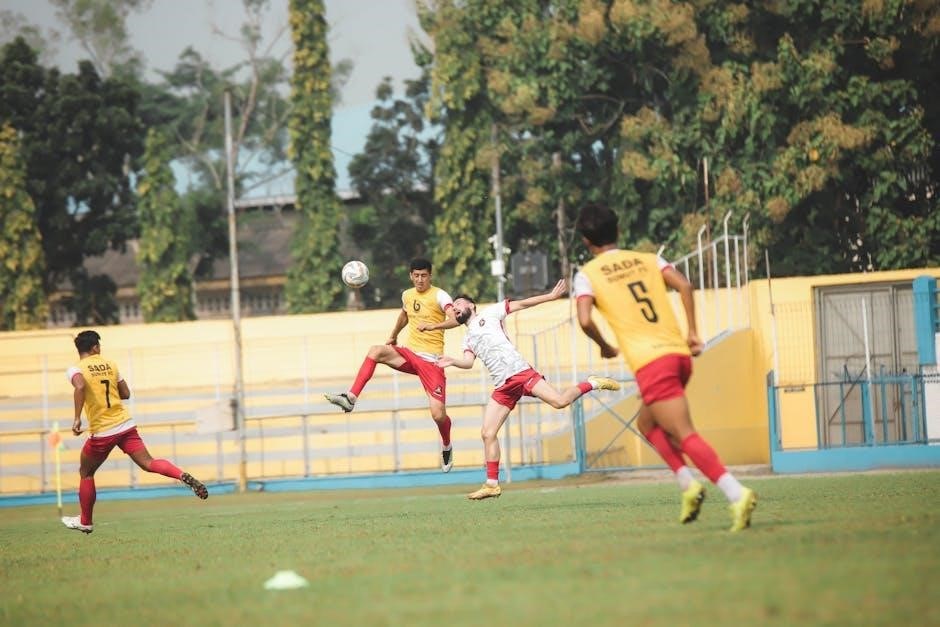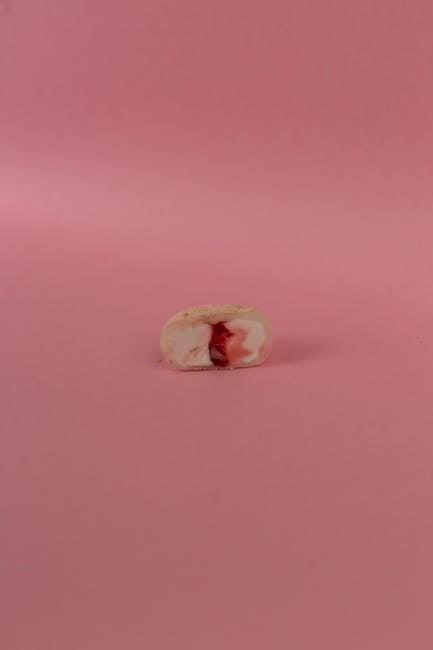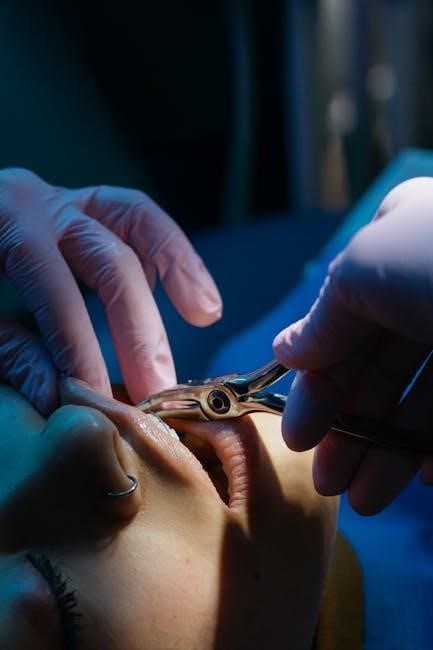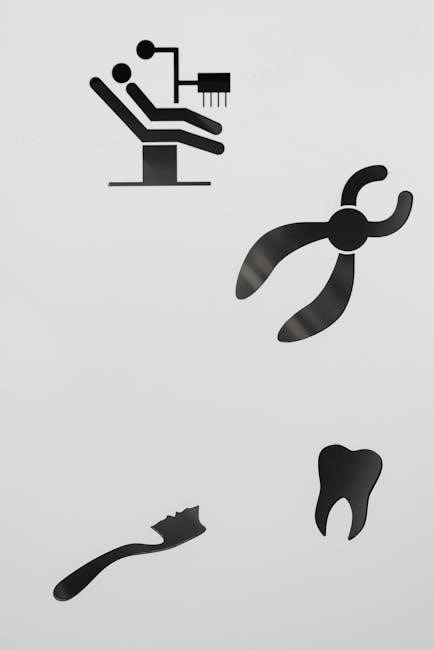Proper post-operative care ensures a smooth recovery after tooth extraction. Following instructions helps prevent complications, promotes healing, and minimizes discomfort. Key steps include controlling bleeding, managing pain, and maintaining oral hygiene.
1.1 Importance of Following Post-Op Instructions
Following post-operative instructions is crucial for a smooth recovery after tooth extraction. Adhering to guidelines helps prevent complications like dry socket or infection, reduces swelling and pain, and promotes proper healing. Ignoring these steps can lead to prolonged discomfort or the need for additional treatments. Compliance ensures the blood clot forms correctly, protecting the extraction site and supporting the recovery process. Proper care minimizes risks and helps patients return to normal activities quickly and safely.
1.2 Overview of the Recovery Process
The recovery process after tooth extraction typically lasts a few days to a week. Immediate steps include biting on gauze to control bleeding and avoiding disturbances to the extraction site. The first 24 hours are critical for clot formation, requiring rest and a soft diet. Swelling and discomfort usually peak within 48 hours but subside as healing progresses. Proper care ensures the extraction site heals smoothly, minimizing complications and allowing patients to resume normal activities within a short period.

Immediate Care After Tooth Extraction
After extraction, avoid eating for 2 hours. Do not consume hot, hard, or sharp foods. Rest and avoid strenuous activities to promote healing and prevent complications.
2.1 Biting on Gauze to Control Bleeding
Bite firmly on the gauze pad provided for 30-45 minutes post-extraction to control bleeding. Replace with a clean pad if bleeding persists. Avoid spitting or rinsing during this period, as this may dislodge the forming clot, which is crucial for healing. Continue biting on gauze as needed to ensure the bleeding stops and the clot stabilizes.
2.2 Avoiding Rinsing or Disturbing the Extraction Site
Do not rinse your mouth or disturb the extraction site for the first 24 hours. Avoid using straws, smoking, or spitting, as these actions can dislodge the blood clot. The clot is essential for healing, and disturbing it may lead to complications like dry socket. Keeping the area undisturbed allows the clot to form properly, promoting a smooth recovery and preventing infection or prolonged healing time.
2.3 First 24 Hours: Do’s and Don’ts
The first 24 hours are critical for healing. Do eat cold, soft foods like yogurt or pudding, and bite gently on gauze for 30-45 minutes to control bleeding. Don’t rinse vigorously, use straws, smoke, or consume hot, hard, or sharp foods. Avoid alcohol and carbonated drinks. Rest and avoid strenuous activities. Gently remove gauze after 45 minutes but do not disturb the extraction site. Follow these guidelines to ensure proper clot formation and a smooth recovery process.

Managing Pain and Discomfort
Managing pain after tooth extraction involves using prescribed medications and applying ice packs to reduce swelling. Avoid smoking and alcohol to prevent complications and use over-the-counter options for mild discomfort.
3.1 Using Prescribed Pain Medications
Prescribed pain medications are essential for managing discomfort after tooth extraction. Always follow your dentist’s instructions precisely to ensure safety and effectiveness. These medications help reduce swelling, inflammation, and pain intensity. Commonly prescribed options include opioids or NSAIDs, which should be taken as directed. Avoid exceeding the recommended dosage to prevent side effects. Inform your dentist of any other medications you are taking to avoid interactions. Take medication with food if needed to reduce stomach discomfort. Monitor for side effects and seek medical advice if they persist.
3.2 Applying Ice Packs to Reduce Swelling
Applying ice packs to the affected area is a common method to reduce swelling after tooth extraction. Wrap an ice pack or a bag of frozen peas in a cloth and place it on the cheek near the extraction site. Apply for 15-20 minutes, then remove for 10 minutes, and repeat as needed. This helps minimize swelling and discomfort. Avoid placing ice directly on the skin to prevent irritation. Ice therapy is most effective within the first 24 hours post-procedure. Consult your dentist if swelling persists or worsens.
3.4 Managing Mild to Moderate Pain
Mild to moderate pain after tooth extraction can be managed with over-the-counter pain relievers like ibuprofen or acetaminophen. Always follow the dosage instructions provided by your dentist. If prescribed, use stronger pain medications as directed. Pain typically subsides within a few days but may persist for up to a week. If pain worsens or lasts longer, contact your dentist. Avoid alcohol and smoking, as they can delay healing and increase pain. Use pain relief medications with food to avoid stomach discomfort.

Dietary Recommendations
Focus on soft, cold foods like yogurt, ice cream, and pudding for the first 24 hours. Avoid hot, hard, or sharp foods to protect the extraction site and promote healing.
4.1 Foods to Eat in the First 24 Hours

Opt for cold, soft foods like ice cream, yogurt, pudding, and sherbet to minimize discomfort. Gentle options such as scrambled eggs, mashed potatoes, and smoothies are also ideal. Avoid hot, spicy, or sharp foods that could irritate the extraction site. Stick to a bland diet to reduce irritation and allow the blood clot to form properly. Proper nutrition supports healing and prevents complications during the initial recovery phase.
4.2 Avoiding Hot, Hard, or Sharp Foods
Avoid consuming hot, hard, or sharp foods for the first 24 hours to prevent irritation or dislodging the blood clot. Hot foods can increase swelling, while hard or sharp foods may damage the extraction site. Stick to a soft, bland diet to promote healing and reduce the risk of complications. Avoid foods like chips, nuts, or raw vegetables during the initial recovery phase to ensure proper healing and minimize discomfort.
4.3 Gradually Introducing Soft Foods
After the first 24 hours, gradually introduce soft, non-irritating foods like yogurt, scrambled eggs, and mashed potatoes. Avoid foods with sharp edges or textures that could disrupt the healing site. Opt for lukewarm or cool foods initially, as hot temperatures may cause discomfort. Soft foods help minimize chewing strain and promote a comfortable recovery. Ensure meals are gentle on the extraction site to avoid irritation or complications during the healing process.

Oral Hygiene After Extraction
Proper oral hygiene after extraction promotes healing and prevents infection. Gently rinse with warm salt water and avoid brushing directly on the extraction site to maintain a clean environment.
5.1 Rinsing with Warm Salt Water
Rinsing with warm salt water is essential for keeping the extraction site clean. Dissolve one teaspoon of salt in a cup of warm water and gently swish around your mouth, focusing on the extraction area. Do this 2-3 times daily, starting 24 hours after the procedure. Avoid harsh movements to prevent dislodging the blood clot. This helps reduce swelling, kills bacteria, and promotes healing without irritating the gums.
5.2 Avoiding Brushing Directly on the Extraction Site
Refain from brushing directly over the extraction site for the first few days. Gently clean the rest of your teeth as usual, but avoid the extraction area to prevent disrupting the blood clot. Using a soft-bristled toothbrush, clean around the site without applying pressure. This precaution helps protect the healing tissue and reduces the risk of complications, ensuring the area heals properly without irritation or infection.
5.3 Using Antimicrobial Mouthwash
Starting 24 hours after extraction, rinse gently with an antimicrobial mouthwash to reduce bacteria and promote healing. Use the mouthwash 2-3 times daily, as directed, to keep the area clean without disturbing the clot. This helps prevent infection and supports recovery. Continue this routine for about a week or as advised by your dentist to ensure proper healing and minimize the risk of complications.

Activity Restrictions
Avoid strenuous activities for 24-48 hours to promote healing. Resting is essential for the first day to prevent dislodging the blood clot and ensure proper recovery.
6.1 Avoiding Strenuous Activities
Avoiding strenuous activities is crucial after tooth extraction to prevent complications. Physical exertion can dislodge the blood clot, leading to dry socket or delayed healing. Patients should rest and avoid heavy lifting, bending, or exercise for at least 24 hours. Gentle movements are acceptable, but prioritizing relaxation helps the body recover effectively. This precaution ensures the extraction site heals properly without interference.
6.2 Resting for the First 24 Hours
Resting for the first 24 hours after tooth extraction is essential for proper healing. Lying down or elevating your head slightly can reduce bleeding and discomfort. Avoid strenuous activities, as physical exertion may dislodge the blood clot or prolong recovery. Relaxation helps your body focus on healing the extraction site effectively. This period of rest is critical for minimizing complications and ensuring a smooth recovery process.
6.3 Avoiding Smoking and Alcohol
Smoking and alcohol consumption should be avoided for at least 24 hours after tooth extraction. Smoking can dislodge the blood clot, leading to dry socket. Alcohol can interfere with healing and prolong recovery. Both habits increase the risk of complications and should be avoided as instructed by your dentist to ensure proper healing and minimize discomfort during recovery.

Monitoring Healing and Complications
Monitor the extraction site for signs of healing, such as clot formation and reduced swelling. Watch for complications like dry socket or infection and seek dental care if symptoms persist.
7.1 Signs of Normal Healing
Normal healing after tooth extraction involves the formation of a blood clot at the extraction site, which gradually heals over several days. Bleeding typically stops within 24 hours, and swelling subsides within 2-3 days. The gums around the site may return to their normal color, and the extraction area begins to close. Pain usually diminishes, and the patient can resume normal activities. Taste and smell often return to normal, and the healing process continues without complications if proper care is followed.
7.2 Identifying Potential Complications
Potential complications after tooth extraction include dry socket, infection, or prolonged bleeding. Signs of complications may include severe pain, fever, swelling, or pus discharge. A dry socket occurs when the blood clot dislodges, exposing the bone. Infection may cause redness, warmth, or a foul taste. If bleeding persists beyond 24 hours, seek medical attention. Any unusual symptoms should be reported to your dentist promptly to prevent further issues and ensure proper healing.
7.3 When to Contact Your Dentist
Contact your dentist if you experience excessive bleeding, severe pain, swelling, or fever. If the extraction site becomes red, warm, or pus is present, it may indicate infection. Notify your dentist if the blood clot dislodges, revealing bone, or if healing is delayed. Additionally, seek immediate care if you have trouble breathing, an allergic reaction to medication, or persistent numbness. Early intervention can address complications and ensure proper recovery.
Proper post-op care is vital for smooth recovery after tooth extraction. Following instructions minimizes discomfort, prevents complications, and supports healing, ensuring the best outcome for your oral health.
8.1 Summary of Key Instructions

Key instructions emphasize protecting the extraction site, managing pain, and maintaining hygiene. Avoid disturbing the site, use ice for swelling, and rinse with salt water after 24 hours. Stick to soft foods initially and gradually reintroduce other foods. Refrain from smoking and alcohol to prevent complications, ensuring a smooth recovery and optimal healing. Adherence to these guidelines is crucial for minimizing discomfort and promoting a successful outcome.
8.2 Importance of Adherence for Optimal Recovery
Adhering to post-operative instructions is vital for a successful recovery. Proper care minimizes risks of complications, such as infection or dry socket, and ensures proper healing. Following guidelines helps maintain the blood clot, reduces swelling, and manages pain effectively. Non-compliance can lead to prolonged recovery, discomfort, or additional treatments. By prioritizing these instructions, patients can achieve the best possible outcomes and return to normal activities swiftly. Consistency and attention to detail are key to a smooth and uneventful healing process.
